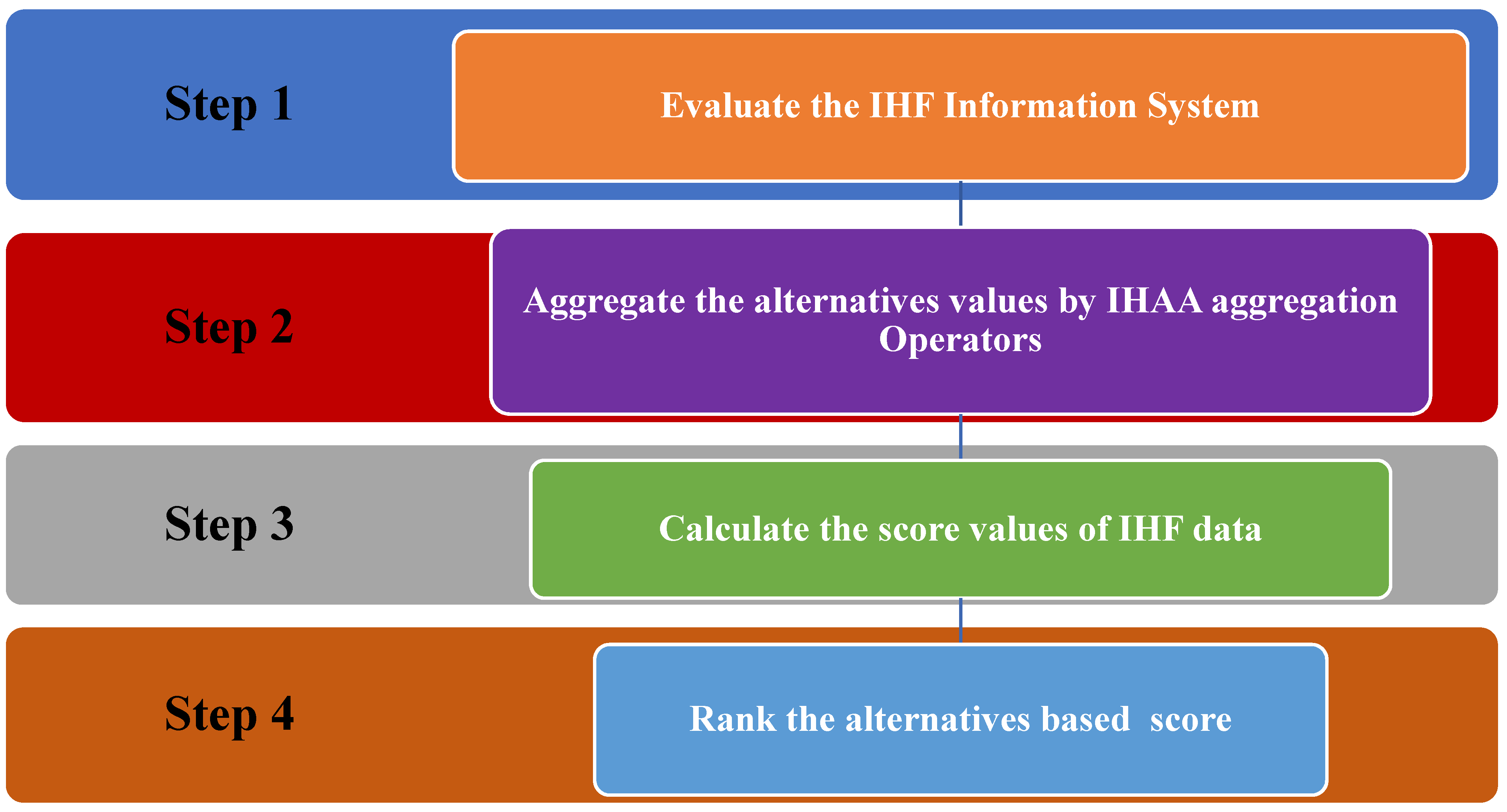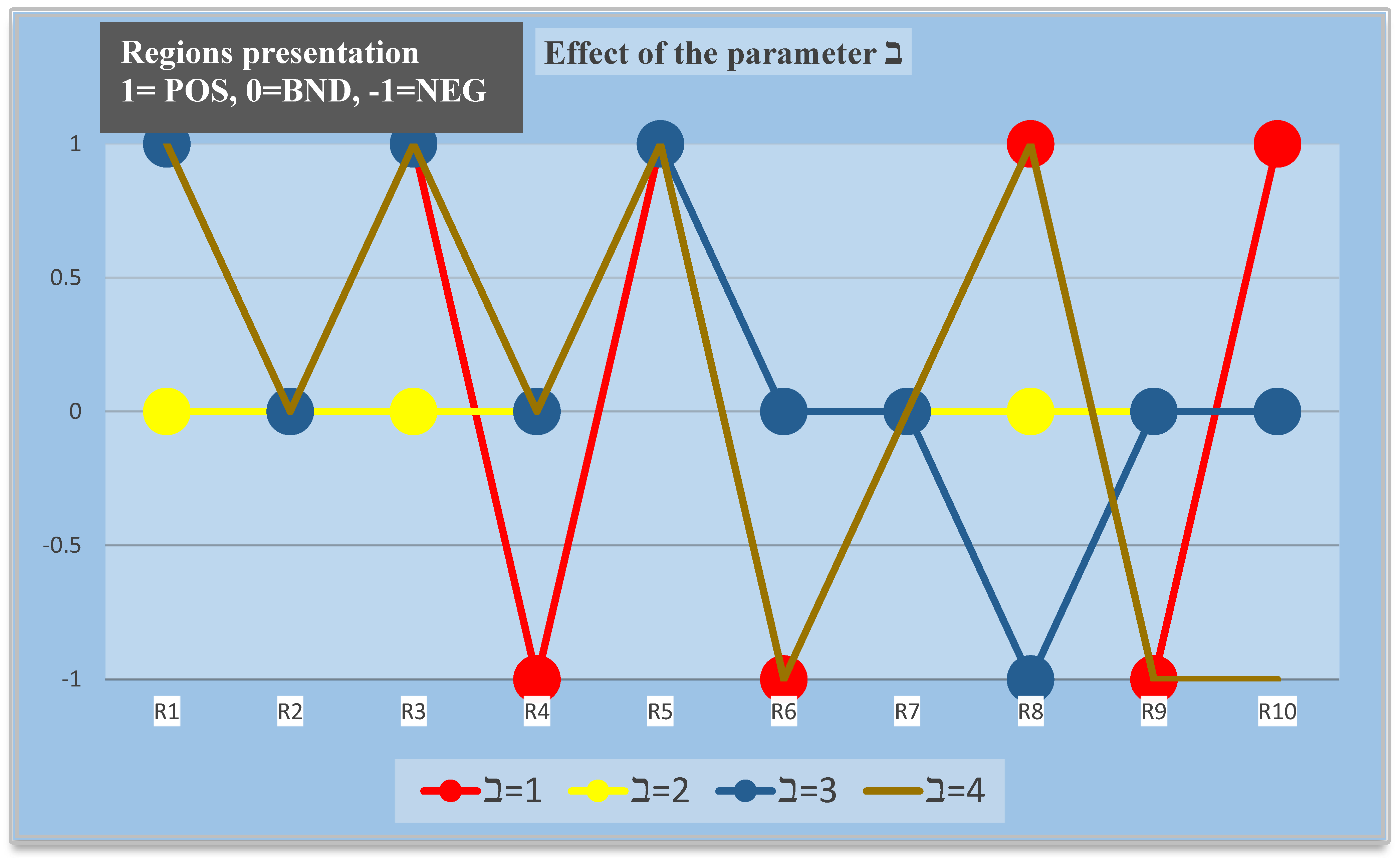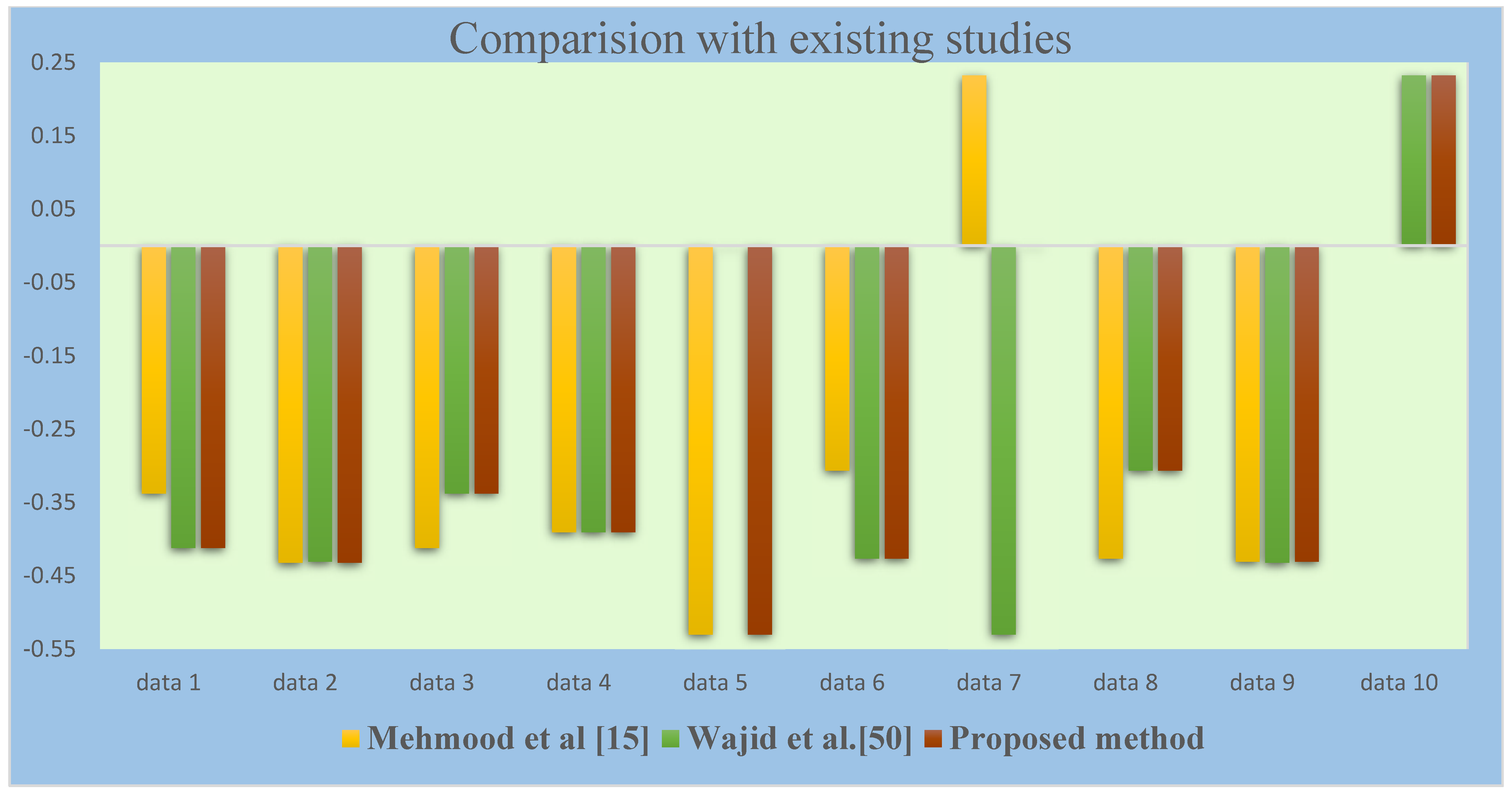An Innovative Decision Model Utilizing Intuitionistic Hesitant Fuzzy Aczel-Alsina Aggregation Operators and Its Application
Abstract
1. Introduction
Motivation
2. Preliminaries
2.1. Intuitionistic Hesitant Fuzzy Sets
- (i)
- (ii)
- (iii)
- (iv)
- (v)
2.2. A Summary of Aczel-Alsina Operators
- 1.
- Symmetry: = .
- 2.
- Associativity:
- 3.
- Monotonicity:
- 4.
- One Identity: ;
- 1.
- Product triangular norm: =;
- 2.
- Minimum triangular norm: ) = min .
- 3.
- Lukasiewicz triangular norm: = max (+).
- 4.
- Drastic triangular norm:
- 1.
- Symmetry: = (, ).
- 2.
- Associativity: (, (, )) = ( (, ), ).
- 3.
- Monotonicity: (, ) (, ) if
- 4.
- Zero Identity: (0, ) = ;
- 1.
- Probabilistic sum : = +;
- 2.
- Maximum : = max .
- 3.
- Lukasiewicz : = min { + }.
- 4.
- Drastic :
2.3. A Review of Three-Way Decision Theory
3. A New Three-Way Decision Model Developed on Intervals for Intuitionistic Hesitant Fuzzy Sets
4. Aczel–Alsina Operators for Intuitionistic Hesitant Fuzzy Sets
- (i)
- =
- (ii)
- (iii)
- (iv)
- (i)
- (ii)
- (iii)
- (iv)
- (v)
- (i)
- (ii)
- This is straightforward.
- (iii)
- Let ; then, ; using this, we obtain
- (iv)
- Now
- (v)
- (vi)
5. A Novel Model for MADM
6. An Algorithm of Three-Way Decision Based on Established Approach
7. Numerical Example
7.1. Evaluation of a Case Study for MADM Approach
7.2. Evaluation of Case Study for Three-Way Decision Approach
7.3. Effect of the Parameter on the Information System
7.4. Benefits of the Approach
- 1.
- Generalization: One of the key advantages of this approach is its greater level of generalization. It extends the theory of IFSs and provides a more inclusive framework. By reducing membership values and non-membership values to singletons, intuitionistic hesitant fuzzy sets can be converted into intuitionistic fuzzy sets.
- 6.
- Aczel–Alsina aggregation operators: The use of Aczel–Alsina aggregation operators is particularly advantageous for decision-making in fuzzy environments. These operators are simple yet effective, and they also consider the element of time. They have been designed specifically for novel data and are employed to aggregate information in a meaningful way.
- 7.
- Improved three-way decision (3WD) approach: Existing approaches in the literature, such as those proposed by Yao [28], are often considered traditional. In contrast, this model introduces new stages for 3WD, containing the plan of Aczel–Alsina aggregation operators and the utilization of interval-valued equivalence classes for approximation spaces. These enhancements make the approach more efficient thanexisting methods.
- 8.
- Business investment decision-making: Making optimal investment decisions is a critical and challenging task for investors, especially in a business context. In this study, we address this problem by establishing an approach that incorporates multiple companies. The effect of the parameter ℶ is demonstrated, showcasing the variation in the positive, negative, and boundary regions. This information aids in making well-informed investment decisions.
8. Comparative Analysis
- Our observations further indicate that [18,45,46,47] demonstrate an effective ability to handling IF and HF information. However, it is important to note that there are specific scenarios where these models may not be suitable. This emphasizes the reliability and efficacy of our established idea for decision-makers.
- The data presented in Table 7 shed light on the contributions of Senapati et al. [45,47], who devised interval-valued IFAAW, interval-valued IFAAWG, and HFAAWA operators specifically for interval-valued intuitionistic fuzzy information and hesitant fuzzy data. Nonetheless, comparative studies have revealed that these approaches lack effectiveness when dealing with intuitionistic hesitant fuzzy data. Hence, our proposed approach provides a solution that addresses more intricate and ambiguous scenarios.
| Approaches | Information | Ranking |
|---|---|---|
| Xu, et al. [46] | IFSs | No |
| Xu, et al. [18] | IFSs | No |
| Senapati, et al. [45] | Interval-IFSs | No |
| Senapati, et al. [45] | Interval-IFSs | No |
| Senapati, et al. [47] | HFSs | No |
| Seikh, et al. [48] | IFSs | No |
| Ahmmad, et al. [49] | IFRSs | No |
| Mahmood, et al. [15] | IHFSs | |
| Wajid, et al. [50] | IHFSs | |
| Proposed approach | IHFSs |
| Approaches | Information | Ranking | ||
|---|---|---|---|---|
| Approaches | Information | Ranking | ||
| Xu, et al. [46] | IFSs | No | No | No |
| Xu, et al. [18] | IFSs | No | No | No |
| Senapati, et al. [45] | Interval-IFSs | No | No | No |
| Senapati, et al. [45] | Interval-IFSs | No | No | No |
| Senapati, et al. [47] | HFSs | No | No | No |
| Seikh, et al. [48] | IFSs | No | No | No |
| Ahmmad, et al. [49] | IFRSs | No | No | No |
| Mahmood, et al. [15] | IHFSs | |||
| Wajid, et al. [50] | IHFSs | |||
| Proposed approach | IHFSs | |||
9. Conclusions
Author Contributions
Funding
Data Availability Statement
Conflicts of Interest
References
- Ardil, C. Vague Multiple Criteria Decision Making Analysis Method for Fighter Aircraft Selection. Int. J. Aerosp. Mech. Eng. 2022, 16, 133–142. [Google Scholar]
- Bourahla, M. Using Rough Set Theory for Reasoning on Vague Ontologies. Int. J. Intell. Syst. Appl. 2022, 14, 21–36. [Google Scholar] [CrossRef]
- Zadeh, L. Fuzzy sets. Inf. Control 1965, 8, 338–353. [Google Scholar] [CrossRef]
- Zhang, L.; Zhang, B. The Quotient Space Theory of Problem Solving. Fundam. Inform. 2004, 59, 287–298. [Google Scholar] [CrossRef]
- Pawlak, Z. Rough set theory and its applications to data analysis. Cybern. Syst. 1998, 29, 661–688. [Google Scholar] [CrossRef]
- Saraji, M.K.; Mardani, A.; Köppen, M.; Mishra, A.R.; Rani, P. An extended hesitant fuzzy set using SWARA-MULTIMOORA approach to adapt online education for the control of the pandemic spread of COVID-19 in higher education institutions. Artif. Intell. Rev. 2021, 55, 181–206. [Google Scholar] [CrossRef]
- Onbaşıoğlu, Ş.; Varol, B.P. Intuitionistic Fuzzy Metric-like Spaces and Fixed-Point Results. Mathematics 2023, 11, 1902. [Google Scholar] [CrossRef]
- Bera, J.; Das, K.C.; Samanta, S.; Lee, J.-G. Connectivity Status of Intuitionistic Fuzzy Graph and Its Application to Merging of Banks. Mathematics 2023, 11, 1949. [Google Scholar] [CrossRef]
- Atanassov, K.T. On Intuitionistic Fuzzy Sets Theory; Springer: Berlin/Heidelberg, Germany, 2012; Volume 283. [Google Scholar]
- Torra, V. Hesitant fuzzy sets. Int. J. Intell. Syst. 2010, 25, 529–539. [Google Scholar] [CrossRef]
- Garg, H.; Keikha, A. Various aggregation operators of the generalized hesitant fuzzy numbers based on Archimedean t-norm and t-conorm functions. Soft Comput. 2022, 26, 13263–13276. [Google Scholar] [CrossRef]
- Resti, Y.; Irsan, C.; Neardiaty, A.; Annabila, C.; Yani, I. Fuzzy Discretization on the Multinomial Naïve Bayes Method for Modeling Multiclass Classification of Corn Plant Diseases and Pests. Mathematics 2023, 11, 1761. [Google Scholar] [CrossRef]
- Guo, Z.; Liu, S. Study on the Selection of Pharmaceutical E-Commerce Platform Considering Bounded Rationality under Probabilistic Hesitant Fuzzy Environment. Mathematics 2023, 11, 1859. [Google Scholar] [CrossRef]
- Albaity, M.; Mahmood, T.; Ali, Z. Impact of Machine Learning and Artificial Intelligence in Business Based on Intuitionistic Fuzzy Soft WASPAS Method. Mathematics 2023, 11, 1453. [Google Scholar] [CrossRef]
- Mahmood, T.; Ali, W.; Ali, Z.; Chinram, R. Power Aggregation Operators and Similarity Measures Based on Improved Intuitionistic Hesitant Fuzzy Sets and their Applications to Multiple Attribute Decision Making. Comput. Model. Eng. Sci. 2021, 126, 1165–1187. [Google Scholar] [CrossRef]
- Yager, R.R. Generalized OWA aggregation operators. Fuzzy Optim. Decis. Mak. 2004, 3, 93–107. [Google Scholar] [CrossRef]
- Yager, R.R. Prioritized aggregation operators. Int. J. Approx. Reason. 2008, 48, 263–274. [Google Scholar] [CrossRef]
- Xu, Z.; Yager, R.R. Some geometric aggregation operators based on intuitionistic fuzzy sets. Int. J. Gen. Syst. 2006, 35, 417–433. [Google Scholar] [CrossRef]
- Zhang, H.; Wei, G.; Chen, X. Spherical fuzzy Dombi power Heronian mean aggregation operators for multiple attribute group decision-making. Comput. Appl. Math. 2022, 41, 1–54. [Google Scholar] [CrossRef]
- Senapati, T.; Chen, G.; Yager, R.R. Aczel–Alsina aggregation operators and their application to intuitionistic fuzzy multiple attribute decision making. Int. J. Intell. Syst. 2021, 37, 1529–1551. [Google Scholar] [CrossRef]
- Ayub, N.; Malik, A. Dual hesitant fuzzy Bonferroni means and its applications in decision-making. Ital. J. Pure Appl. Math. 2022, 48, 32–53. [Google Scholar]
- Hadi, A.; Khan, W.; Khan, A. A novel approach to MADM problems using Fermatean fuzzy Hamacher aggregation operators. Int. J. Intell. Syst. 2021, 36, 3464–3499. [Google Scholar] [CrossRef]
- Yao, Y. Three-Way Decisions and Cognitive Computing. Cogn. Comput. 2016, 8, 543–554. [Google Scholar] [CrossRef]
- Yao, Y. An outline of a theory of three-way decisions. In Proceedings of the International Conference on Rough Sets and Current Trends in Computing, Chengdu, China, 17–20 August 2012; Springer: Berlin/Heidelberg, Germany, 2012. [Google Scholar]
- Yao, Y. The geometry of three-way decision. Appl. Intell. 2021, 51, 6298–6325. [Google Scholar] [CrossRef]
- Mehmood, A.; Shaikh, I.U.H.; Ali, A. Application of Deep Reinforcement Learning for Tracking Control of 3WD Omnidirectional Mobile Robot. Inf. Technol. Control. 2021, 50, 507–521. [Google Scholar] [CrossRef]
- Zhang, C.; Ding, J.; Li, D.; Zhan, J. A novel multi-granularity three-way decision making approach in q-rung orthopair fuzzy information systems. Int. J. Approx. Reason. 2021, 138, 161–187. [Google Scholar] [CrossRef]
- Yao, Y.; Deng, X. Sequential three-way decisions with probabilistic rough sets. In Proceedings of the IEEE 10th International Conference on Cognitive Informatics and Cognitive Computing (ICCI-CC’11), Banff, AB, Canada, 18–20 August 2011. [Google Scholar]
- Zhao, T.; Zhang, Y.; Miao, D. Intuitionistic Fuzzy-Based Three-Way Label Enhancement for Multi-Label Classification. Mathematics 2022, 10, 1847. [Google Scholar] [CrossRef]
- Liu, D.; Yao, Y.; Li, T. Three-way investment decisions with decision-theoretic rough sets. Int. J. Comput. Intell. Syst. 2011, 4, 66–74. [Google Scholar]
- Zhang, K.; Dai, J. A novel TOPSIS method with decision-theoretic rough fuzzy sets. Inf. Sci. 2022, 608, 1221–1244. [Google Scholar] [CrossRef]
- Qian, Y.; Zhang, H.; Sang, Y.; Liang, J. Multigranulation decision-theoretic rough sets. Int. J. Approx. Reason. 2014, 55, 225–237. [Google Scholar] [CrossRef]
- Ali, Z.; Mahmood, T.; Smarandache, F. Three-Way Decisions with Single-Valued Neutrosophic Uncertain Linguistic Decision-Theoretic Rough Sets Based on Generalized Maclaurin Symmetric Mean Operators. Neutrosophic Oper. Res. 2021, 71–101. [Google Scholar] [CrossRef]
- Abdullah, S.; Almagrabi, A.O.; Ullah, I. A New Approach to Artificial Intelligent Based Three-Way Decision Making and Analyzing S-Box Image Encryption Using TOPSIS Method. Mathematics 2023, 11, 1559. [Google Scholar] [CrossRef]
- Menger, K. Statistical metrics. Proc. Natl. Acad. Sci. USA 1942, 28, 535. [Google Scholar] [CrossRef]
- Deschrijver, G.; Cornelis, C.; Kerre, E.E. On the representation of intuitionistic fuzzy t-norms and t-conorms. IEEE Trans. Fuzzy Syst. 2004, 12, 45–61. [Google Scholar] [CrossRef]
- Drossos, C. Generalized t-norm structures. Fuzzy Sets Syst. 1999, 104, 53–59. [Google Scholar] [CrossRef]
- Boixader, D.; Recasens, J. Vague and fuzzy t-norms and t-conorms. Fuzzy Sets Syst. 2022, 433, 156–175. [Google Scholar] [CrossRef]
- Ashraf, S.; Abdullah, S.; Aslam, M.; Qiyas, M.; Kutbi, M.A. Spherical fuzzy sets and its representation of spherical fuzzy t-norms and t-conorms. J. Intell. Fuzzy Syst. 2019, 36, 6089–6102. [Google Scholar] [CrossRef]
- Pap, E.; Bošnjak, Z.; Bošnjak, S. Application of fuzzy sets with different t-norms in the interpretation of portfolio matrices in strategic management. Fuzzy Sets Syst. 2000, 114, 123–131. [Google Scholar] [CrossRef]
- Rasuli, R. Fuzzy Equivalence Relation, Fuzzy Congrunce Relation and Fuzzy Normal Subgroups on Group G over T-Norms. Asian J. Fuzzy Appl. Math. 2019, 7. [Google Scholar] [CrossRef]
- Klement, E.P.; Mesiar, R.; Pap, E. Generated triangular norms. Kybernetika 2000, 36, 363–377. [Google Scholar]
- Aczél, J.; Alsina, C. Characterizations of some classes of quasilinear functions with applications to triangular norms and to synthesizing judgements. Aequ. Math. 1982, 25, 313–315. [Google Scholar] [CrossRef]
- Hussain, A.; Ullah, K.; Yang, M.-S.; Pamucar, D. Aczel-Alsina Aggregation Operators on T-Spherical Fuzzy (TSF) Information With Application to TSF Multi-Attribute Decision Making. IEEE Access 2022, 10, 26011–26023. [Google Scholar] [CrossRef]
- Senapati, T.; Chen, G.; Mesiar, R.; Yager, R.R. Novel Aczel–Alsina operations-based interval-valued intuitionistic fuzzy aggregation operators and their applications in multiple attribute decision-making process. Int. J. Intell. Syst. 2021, 37, 5059–5081. [Google Scholar] [CrossRef]
- Xu, Z. Intuitionistic Fuzzy Aggregation Operators. IEEE Trans. Fuzzy Syst. 2007, 15, 1179–1187. [Google Scholar] [CrossRef]
- Senapati, T.; Chen, G.; Mesiar, R.; Yager, R.R.; Saha, A. Novel Aczel–Alsina operations-based hesitant fuzzy aggregation operators and their applications in cyclone disaster assessment. Int. J. Gen. Syst. 2022, 51, 511–546. [Google Scholar] [CrossRef]
- Seikh, M.R.; Mandal, U. Intuitionistic fuzzy Dombi aggregation operators and their application to multiple attribute decision-making. Granul. Comput. 2019, 6, 473–488. [Google Scholar] [CrossRef]
- Ahmmad, J.; Mahmood, T.; Mehmood, N.; Urawong, K.; Chinram, R. Intuitionistic Fuzzy Rough Aczel-Alsina Average Aggregation Operators and Their Applications in Medical Diagnoses. Symmetry 2022, 14, 2537. [Google Scholar] [CrossRef]
- Ali, W.; Shaheen, T.; Toor, H.G.; Akram, F.; Uddin, Z.; Hassan, M.M. Selection of Investment Policy Using a Novel Three-Way Group Decision Model under Intuitionistic Hesitant Fuzzy Sets. Appl. Sci. 2023, 13, 4416. [Google Scholar] [CrossRef]
- Ali, W.; Shaheen, T.; Haq, I.U.; Toor, H.G.; Akram, F.; Jafari, S.; Uddin, Z.; Hassan, M.M. Multiple-Attribute Decision Making Based on Intuitionistic Hesitant Fuzzy Connection Set Environment. Symmetry 2023, 15, 778. [Google Scholar] [CrossRef]
- Radenovic, S.; Ali, W.; Shaheen, T.; Haq, I.U.; Akram, F.; Toor, H. Multiple Attribute Decision-Making Based on Bonferroni MeanOperatorsunderSquare Root Fuzzy Set Environment. J. Comput. Cogn. Eng. 2022. [Google Scholar] [CrossRef]
- Atanassov, K. On Intuitionistic Fuzzy Temporal Topological Structures. Axioms 2023, 12, 182. [Google Scholar] [CrossRef]
- Wang, Z.; Miao, D. Spatial-temporal single object tracking with three-way decision theory. Int. J. Approx. Reason. 2023, 154, 38–47. [Google Scholar] [CrossRef]
- Ul Haq, I.; Shaheen, T.; Ali, W.; Senapati, T. A Novel SIR Approach to Closeness Coefficient-Based MAGDM Problems Using Pythagorean Fuzzy Aczel–Alsina Aggregation Operators for Investment Policy. Discret. Dyn. Nat. Soc. 2022, 2022, 5172679. [Google Scholar] [CrossRef]




| Objects\Operators | |
|---|---|
| Objects | |
|---|---|
| Operator | Ranking |
|---|---|
| D | |||||
|---|---|---|---|---|---|
| Yes | |||||
| Yes | |||||
| Yes | |||||
| No | |||||
| Yes | |||||
| No | |||||
| No | |||||
| Yes | |||||
| No | |||||
| No |
| Positive Regions | Negative Regions | Boundary Regions | |
|---|---|---|---|
Disclaimer/Publisher’s Note: The statements, opinions and data contained in all publications are solely those of the individual author(s) and contributor(s) and not of MDPI and/or the editor(s). MDPI and/or the editor(s) disclaim responsibility for any injury to people or property resulting from any ideas, methods, instructions or products referred to in the content. |
© 2023 by the authors. Licensee MDPI, Basel, Switzerland. This article is an open access article distributed under the terms and conditions of the Creative Commons Attribution (CC BY) license (https://creativecommons.org/licenses/by/4.0/).
Share and Cite
Ali, W.; Shaheen, T.; Toor, H.G.; Akram, F.; Uddin, M.Z.; Hassan, M.M. An Innovative Decision Model Utilizing Intuitionistic Hesitant Fuzzy Aczel-Alsina Aggregation Operators and Its Application. Mathematics 2023, 11, 2768. https://doi.org/10.3390/math11122768
Ali W, Shaheen T, Toor HG, Akram F, Uddin MZ, Hassan MM. An Innovative Decision Model Utilizing Intuitionistic Hesitant Fuzzy Aczel-Alsina Aggregation Operators and Its Application. Mathematics. 2023; 11(12):2768. https://doi.org/10.3390/math11122768
Chicago/Turabian StyleAli, Wajid, Tanzeela Shaheen, Hamza Ghazanfar Toor, Faraz Akram, Md. Zia Uddin, and Mohammad Mehedi Hassan. 2023. "An Innovative Decision Model Utilizing Intuitionistic Hesitant Fuzzy Aczel-Alsina Aggregation Operators and Its Application" Mathematics 11, no. 12: 2768. https://doi.org/10.3390/math11122768
APA StyleAli, W., Shaheen, T., Toor, H. G., Akram, F., Uddin, M. Z., & Hassan, M. M. (2023). An Innovative Decision Model Utilizing Intuitionistic Hesitant Fuzzy Aczel-Alsina Aggregation Operators and Its Application. Mathematics, 11(12), 2768. https://doi.org/10.3390/math11122768









